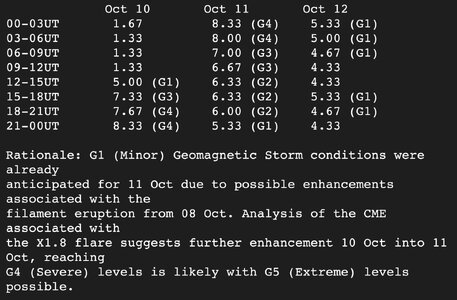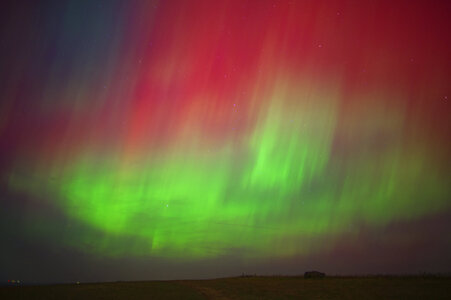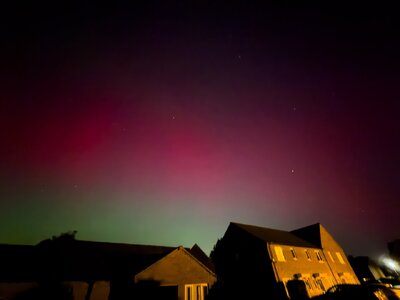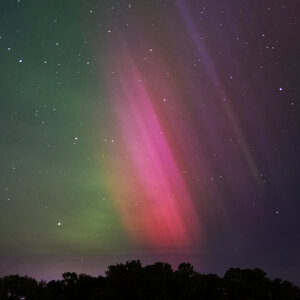-
While Stormtrack has discontinued its hosting of SpotterNetwork support on the forums, keep in mind that support for SpotterNetwork issues is available by emailing [email protected].
You are using an out of date browser. It may not display this or other websites correctly.
You should upgrade or use an alternative browser.
You should upgrade or use an alternative browser.
Aurora Alert Oct 10-11, 2024
- Thread starter William Monfredo
- Start date
Andy Wehrle
EF5
Finally photographing an aurora has been on my bucket list for a while. Missed the big display back in May because I didn't think the clouds over southern Wisconsin would clear in time. Missed early this week because the event was initially expected Friday-Saturday nights and ended up being Sunday-Monday instead. Maybe this time...
Dan Robinson
EF5
Looks like another solid chance for a high-end event similar to what we saw on May 10. For us down here, it's going to have to happen tomorrow (Thursday) night since a frontal system is progged to bring clouds in shortly after sunset on Friday.
William Monfredo
EF4
Dan Robinson
EF5
Not as bright as May 10, but the 9pm cdt Thursday night substorm was visible in downtown St. Louis.
JamesCaruso
Staff member
Here are some pics from Newtown, PA, about 35 miles northeast of Philadelphia. Just used an iPhone. Aside from a pink hue at times, it was mostly invisible to the naked eye and only prominently seen through the lens of the iPhone camera. However, I did not “chase” this in a place without light pollution; a local chaser buddy that did got much better pics and said he was able to see pillars with the naked eye. Just like with storm chasing, I failed to optimize the opportunity, this time because my wife and I had tickets to a concert. But it was a nice treat when we got out of there at 10pm ET and now I can say I got the 2024 trifecta of tornado, eclipse totality and aurora (plus an earthquake!) The May aurora was clouded out so that made this one really great to see. Supposedly there is a chance tonight too, at least that’s what the local papers are saying, but the space weather forecast doesn’t show that, what do you all think?
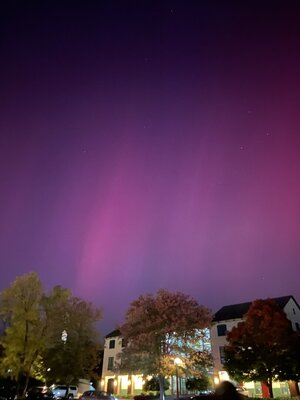
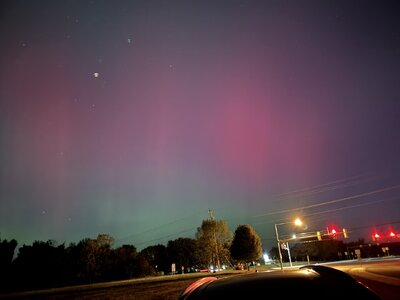
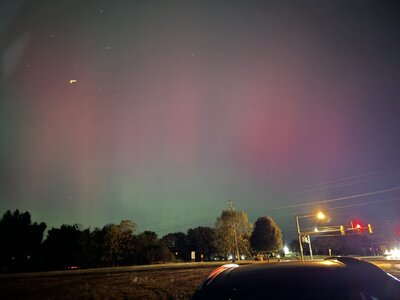
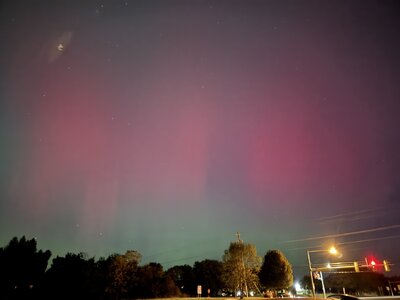
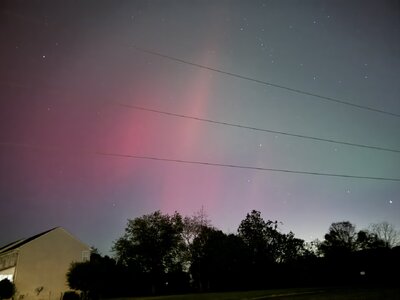
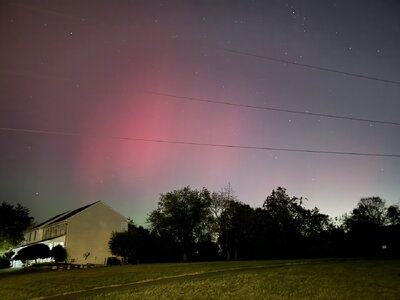






Jamie H
EF3
I only saw this was happening as I was scrolling Instagram, but was pretty amazed to be able to capture something like this, in a suburban area, on an iPhone, in the UK. I was able to see the reds with the naked eye, as a browny, dullish colour. It's not a full bucket list item ticked off, but delighted to have witnessed it!
Attachments
William Monfredo
EF4
Always good to get away from city & light pollution, but then again, I had a half moon glaring behind me about a third of the way up in the sky.I did not “chase” this in a place without light pollution...
And it seems the actual events fire up so suddenly, and they can disappear or change so quickly. It's visually stunning...and then, where'd it go?
I've also wanted to say for some time that I really like the St. Louis Arch, and Dan has done amazing shots
I've seen some absolutely amazing photos from this one, and even nice ones from southern states.
I didn't 'chase' this or even leave home for that matter ... the farthest I made it was from my bedroom up to the roof .lol. (too many trees in the way for any sorta view from the yard or even the deck). In the first wave - somewhere between 8-8:30pm(mountain time) I actually saw a couple little areas of faint red glow. The type of thing you'd easily miss if you weren't specifically looking for it. Interestingly, I was to some degree laying down & looking northward, but also very much so 'up' seeing these (there was nothing at all looking north - except the normal dull starless sky)
While nothing great like so many others around the county saw, it was still cool (and rare) to see.. Something! Anything at all! This and the one back in may are the only times I've ever seen any aurora colors. (I one of the biggest issues limiting me seeing anything is to my northeast is a large city, with suburbs spread all along the northern direction. There is so much skyglow/light-pollution that I don't see stars even on a normal night looking north).
I didn't 'chase' this or even leave home for that matter ... the farthest I made it was from my bedroom up to the roof .lol. (too many trees in the way for any sorta view from the yard or even the deck). In the first wave - somewhere between 8-8:30pm(mountain time) I actually saw a couple little areas of faint red glow. The type of thing you'd easily miss if you weren't specifically looking for it. Interestingly, I was to some degree laying down & looking northward, but also very much so 'up' seeing these (there was nothing at all looking north - except the normal dull starless sky)
While nothing great like so many others around the county saw, it was still cool (and rare) to see.. Something! Anything at all! This and the one back in may are the only times I've ever seen any aurora colors. (I one of the biggest issues limiting me seeing anything is to my northeast is a large city, with suburbs spread all along the northern direction. There is so much skyglow/light-pollution that I don't see stars even on a normal night looking north).
Dan Robinson
EF5
The KP8 and 9 events will be visible in even the worst light pollution. It's always better out in dark rural areas of course, but the selection of interesting foregrounds are limited out there. I only have a couple of them (railroad related) out near my town that I've really been playing out.
Even the brightest aurora need high-ISO, wide-open-aperture long exposures, which is really a challenge in urban areas. Any artificial light sources will blow out easily at those exposure settings in a city. I got much better results during the May 10 event because not only were the auroras brighter, but the Arch's floodlights were turned off to not interfere with the migrating birds. I was able to do 25 second exposures thanks to those lights being off. This time the floodlights were on, and there wasn't a way to keep the brighter parts of that illumination from completely blowing out (past the point of RAW highlight correction) on any exposure setting that was long enough to get the aurora to show up (in this case, 8 seconds). In hindsight I should have done one proper exposure of the Arch and layered/stacked that over the blown out parts, but didn't think to do it at the time.
Even the brightest aurora need high-ISO, wide-open-aperture long exposures, which is really a challenge in urban areas. Any artificial light sources will blow out easily at those exposure settings in a city. I got much better results during the May 10 event because not only were the auroras brighter, but the Arch's floodlights were turned off to not interfere with the migrating birds. I was able to do 25 second exposures thanks to those lights being off. This time the floodlights were on, and there wasn't a way to keep the brighter parts of that illumination from completely blowing out (past the point of RAW highlight correction) on any exposure setting that was long enough to get the aurora to show up (in this case, 8 seconds). In hindsight I should have done one proper exposure of the Arch and layered/stacked that over the blown out parts, but didn't think to do it at the time.
Last edited:
JamesCaruso
Staff member
It’s interesting that of the pictures I posted above, I think the better ones are those that have the traffic lights and lights of the town in the foreground. Those are also the ones that contain more green light. I purposely moved to the other side of the town, which is where the bottom two images were taken, but those are not as good in my opinion. Any idea why that would be the case? I realize the northern lights intensity changes over time and are not static, but the change in position only took 5 minutes. Is it possible that the town lights somehow enhanced the photos (recognizing they were just taken with an iPhone camera)?
Dan Robinson
EF5
Part of that is today's phones are really good at low light imagery. They're doing HDR stuff on-the-fly that can avoid blowing out highlights, all with the cost of less clarity in the final image though. Also the auroras do change in intensity on a minute-by-minute basis. The October 6-8 events had a couple of nice substorms, but they didn't last long enough for the 10-20 minutes it took me to drive to my spot and get set up.
There was a point that the glow of 'city light' ( *much worse* than what you have there) looked like it had a slight green-ish tint, that I just chalked up to eyes 'seeing things' ... that makes me wonder more if I actually may have seen green through all that light.JamesCaruso said:I think the better ones are those that have the traffic lights and lights of the town in the foreground. Those are also the ones that contain more green light
That I did notice.. while I was basically laying there watching what I saw, it kinda faded in & out while drifting slowly westward.Dan Robinson said:Also the auroras do change in intensity on a minute-by-minute basis.
Also may have been just tricks of the eyes, but I thought I saw a couple what I can only describe as static flashes/sparks (deff wasn't lightning since much much smaller/dimmer than that, and what clouds there were, were small scattered bits certainly not capable of producing lightning).
(And as a side-note pretty surprizeing just how many planes are out flying around at night)
------------------
I did try taking some pic's, & got nothing, but while my camera(camcorder) has manual settings for 'shutter' & 'iris', it can't do long exposures.
John Farley
Supporter
Here are a couple pictures from Pagosa Springs, CO, looking north across Village Lake:
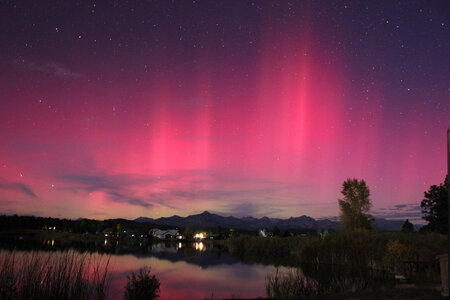
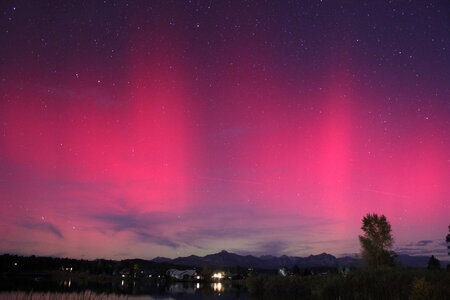
Again like Monday, my savior was a local newscast, this time from Denver, that alerted me to their visibility in Colorado. About 15 minutes earlier I had checked an online aurora tracker, which suggested nothing south of Iowa, but then I heard otherwise on the news so decided to head out. It was nothing close to this with the naked eye, though pillars were dimly visible at times, and a little reddish color. But the camera can capture so much more than the naked eye.


Again like Monday, my savior was a local newscast, this time from Denver, that alerted me to their visibility in Colorado. About 15 minutes earlier I had checked an online aurora tracker, which suggested nothing south of Iowa, but then I heard otherwise on the news so decided to head out. It was nothing close to this with the naked eye, though pillars were dimly visible at times, and a little reddish color. But the camera can capture so much more than the naked eye.
William Monfredo
EF4
Similar threads
- Replies
- 367
- Views
- 71K

